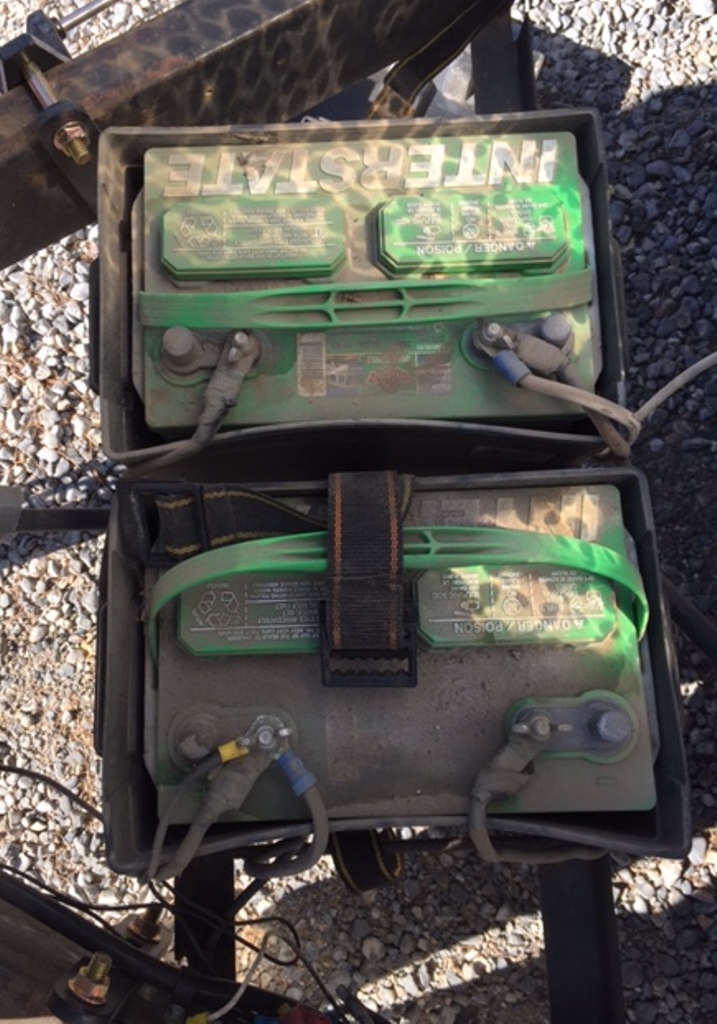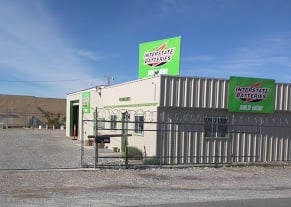During a recent trip traveling along the California-Nevada border and the eastern Sierras, the deep-cycle batteries in my RV weren’t recharging well. We had been boondocking every night along the way and the nights were cold, dropping into the twenties most of the time.
We moved almost every day, so between the charge line in my tow vehicle and running the generator every morning I was pretty sure I was doing enough to keep them charged.
However, after the monitor panel continued to show the battery level on the lowest mark when running the furnace and showering several mornings in a row, I began to believe it was time for new batteries. After all, they were seven and a half years old (which is about twice the average lifespan for a deep-cycle RV battery), had been cycled hundreds of times and I was demanding a lot from them in cold weather.
The only town of any significant size that we would be traveling through was Pahrump, Nevada. Being a fan of Interstate batteries (the current ones had given me years of service) I checked the manufacturer’s website a couple of days before we would be arriving only to discover they didn’t have a distributor in town, only dealers made up mainly of tire stores.
I was doubtful the tire stores could adequately check my old batteries, and if they did test bad, we would probably have to wait a day or two for new batteries to be shipped from Las Vegas as tire stores most likely wouldn’t stock the deep-cycle RV batteries I wanted.

Take a picture before removing
At this point, I just resigned myself to stopping at the Pahrump Walmart and replacing my batteries with a couple of their deep-cycle batteries. However, as my wife and I were headed to Pahrump we picked up a local Pahrump radio station and heard an advertisement for free battery checks from Pahrump Valley Battery the local Interstate battery distributor.
This was a game-changer! To properly check the batteries I knew they would need to be fully charged, so instead of Walmart, we headed to an RV park to allow the batteries to charge overnight. The next morning I called Pahrump Valley Battery to confirm the “Free battery Check” offer that I heard on the radio, which they did.
Removing the batteries from the RV we made the short trip from the RV park to Pahrump Valley Battery, where the owner came out to my truck to remove the batteries from the bed and placed them on his test bench. I told him they were seven and a half years old and were probably shot, but he proceeded to test them.
I expected him just to do a standard load test on them, but to my surprise, he started by popping the cell caps and using a hydrometer to test each individual cell, all tested good. He then tested each battery using a carbon pile load tester with the appropriate load for the appropriate period of time. Again, both batteries passed the test.

My hero!
He then proclaimed I didn’t need new batteries, and we both agreed that I must have let them discharge too much while boondocking. The owner proceeded to load them back into my truck, and sent me on my way, wishing me a good day and safe travels.
Not only did I get a free battery check, but some of the best customer service I have received in a long time and I didn’t spend a nickel! He could have just as easily told me the batteries had reached their life expectancy and I would have gladly paid him a couple hundred dollars for new batteries as I was totally expecting it.
Many snowbirds call Pahrump, Nevada home for the winter. If you are one of them and have problems with your RV batteries be sure to visit Pahrump Valley Battery located at 370 S. Emery Street. Phone: 775-209-0297
If you ever find the need to remove the batteries from your RV, be sure to take a photo before you disconnect the wire. Then when you go to reinstall them or new ones, you will have a wiring schematic. Note: Unlike automotive battery leads, the black wire is typically the positive lead of the house batteries in RVs and the white negative.
Finding an honest business with outstanding customer service… one of the greatest adventures in RVing!

I have a bank of RV/Marine batteries, purchased from Costco. that are now over 10 years old. All hold a charge and have tested good using a load tester and hydrometer. One a year older than the rest was very low on fluid, which I replenished, still tested good.
I think one reason why they have lasted over 10 years is because I’ve never allowed them to fall under a 50 percent charge.
I”ve read actual deep cycle batteries such as Trojan, etc. can typically last from 15 to 20 years if properly maintained.
The key point is to not allow the batteries to fall under 50 percent charge, at least for very long without some sort of charge from a geny, solar, shore power, etc. Also minimally you need 3 or 4 stage charger.
When I upgraded my battery bank I replaced the RV (AC/DC) charger with a Progressive Dynamics 9280, which is a 4 stage charger.
The PD9280 constantly monitors the RV battery, and then automatically adjusts the converter output
voltage based on its charge status, To (4) four operating Modes (BOOST, NORMAL,
STORAGE and EQUALIZE).
BOOST MODE: If the converter senses that the battery voltage has dropped below a preset level the output voltage is increased to approximately 14.4 volts DC to rapidly recharge the battery.
NORMAL MODE: Output voltage set at approximately 13.6 volts DC.
STORAGE MODE: When the converter senses that there has been no significant battery usage for 30 hours the output voltage is reduced to 13.2 volts DC for minimal water usage.
* When in storage mode the microprocessor automatically increases the output voltage to 14.4 volts DC for 15 minutes every 21 hours to help reduce sulfation of the battery plate
My solar charger has the same charging features plus PWM (pulse width modulation) which also helps to preserve batteries for longer lifespans.
Thanks for sharing. A 3 or 4 stage charger is key to longer battery life.
My solar charger is a 3 stage with the same features and a remote readout, but the RV converter/charger is a ‘dumb’ charger (leave it to Jayco to go cheap) so I was glad to see this, I will be looking into swapping it out for the PD9280 this winter. I have had good luck with the Costco Golf Cart batteries, last set lasted 6 years and was still in the coach when I sold it.
How do you know what stage charger you have or what brand makes a 3 or 4 stage charger. ?
I have a WESCO, but there are many other brands out there.
I have 3 battery chargers and I never notice what stage they are. Going out in the shop in the morning and check them. Thanks
Steven
Your welcome!
I’m new to RV’ing (soon to be obvious) and am getting conflicting opinions on winter battery care. Several people (including 1 local RV dealer) told me it was safe to leave my RV batteries in my coach over the winter as long as they were fully charged to start out.
Other people (including another local RV dealer) told me I should pull them out and store them someplace warm.
I live in Alaska – it does get below zero here. I won’t be using the RV again until spring. Is there an absolutely right or wrong answer to this? Thanks!
De in Alaska
De,
They are both right – kind of. A fully charged battery is unable to freeze. However, just because it started out charged, doesn’t mean it will stay charged all winter. Therefore it is best practice to remove them and store them someplace above freezing. Hope this helps.
Get a battery minder!
Best $25 you can spend
I lived in Alaska for 3 years, and bought a small electric ‘battery blanket’ to keep my battery ‘warm’ at night. Really hard on batteries up there and keeping it warm helps it live longer plus the benefit of no ‘slow cranking’ first think in the morning. By all means put a good battery tender/minder on the batteries, it won’t charge them but will replace any parasitic loss from sitting.
How long do standard deep cycle batteries last. Mine have to be replaced every 5-6 years.
Ed,
Depends on quality of the battery and quality of the charger.. With my old trailer and cheap converter charger (that would over charge) 3-4 yrs, with my new trailer and a three stage charger I am going on 9 years on my Interstate deep cycles.
Parallel 12 V batteries can develop a current loop between them and both will discharge. The best hookup is to make sure there are only 6 cells in the circuit. This means that the best hookup is two 6 V batteries in series. This will give you the necessary Amp Hours without internal current loops. Golf cart batteries are deep cycle.
It is also good PM procedure to keep the tops of your batteries clean. The dust that collects on them becomes conductive, especially at night with dampness in the air, the moist dust will short across the terminals and slow drain the cells.
So I bought a used Class C recently that has two 12v deep cycle batteries. I also have 2 nearly new 6volt golf cart batteries that I pulled out of my old trade in. Would it be smart to switch to the Golf Cart batteries?
Good charging requires that you keep battery terminals tight to preventing corrosion. Those wing nuts on the battery are a problem. You cannot get the terminals tight enough with them. Replace them with hex nuts and tighten them with a wrench. Another problem is the stack of leads that seems to happen on the battery stud. Don’t let there be more than 2 and make sure the heaviest lead is closest to the battery.